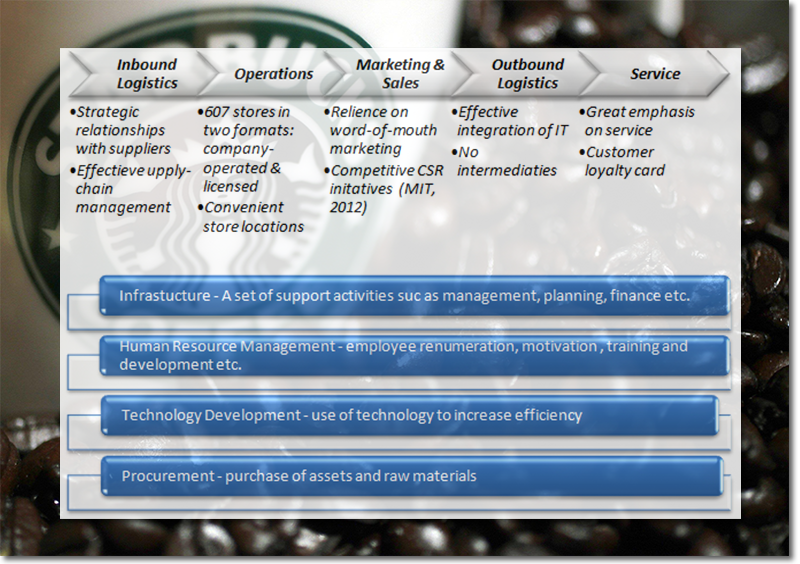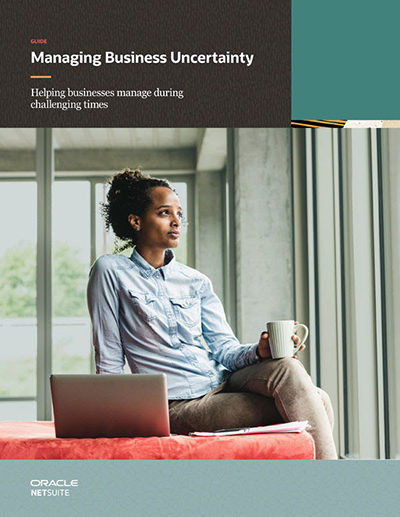Starbucks as an Example of the Value Chain Model

The concept of value chain helps to understand and segregate the useful (which help in gaining a competitive edge) and wasteful activities (which hamper market lead) accompanying each step during the product development process.
The business management concept of the value chain was introduced and described by Michael Porter in his popular book “Competitive Advantage: Creating and Sustaining Superior Performance” in 1985.
A value chain is a series of activities or processes which aims at creating and adding value to an article (product) at every step during the production process.
Businesses aim at enhancing their margins and thus work to change input into an output which is of a greater value than what it was at the time of entering the process (the difference between the two being the company’s profit margin).
Thus the logic behind it is simple; the more value a company creates, the more profitable it is. When more value is created, the same is passed on to the customers and thus further helps in consolidating a competitive edge.
The business activities are divided into primary activities and secondary activities. The primary activities are directly related to the creation of a good or service while the support activities help in enhancing the efficiency and work to obtain a competitive advantage among peers. (Related Reading: Industry Handbook: Porter’s 5 Forces Analysis)
Let’s take the example of Starbucks to understand this better
The Starbucks journey began with a single store in Seattle in the year 1971 to become one of the most recognized brands globally. Starbucks mission is, per its web site, “to inspire and nurture the human spirit – one person, one cup and one neighborhood at a time.”
Starbucks Value-Chain Analysis 2014
John Dudovskiy
Value-chain analysis is an analytical framework that is used to analyse relationships between various parts of operations and the manner in which each part adds value to contribute to the level of revenues. Company value-chain can be divided into two groups: primary and support activities.
Business’s inbound logistics, operations, marketing and sales, outbound logistics, and service are considered as primary activities in value-chain as they are involved in value creation in a direct manner. Support activities in value creation, on the other hand, include infrastructure, human resources management, and procurement.
The following figure represents Starbucks Value-Chain analysis for the UK market:

The value of value-chain analysis in practical level can be explained in a way that it allow to critically analyse each component of a business practice in an individual manner, and search additional sources for competitive advantage within the component.
PRIMARY ACTIVITIES
Inbound Logistics
The inbound logistics for Starbucks refers to selecting the finest quality of coffee beans by the company appointed coffee buyers from coffee producers in Latin America, Africa and Asia. In the case of Starbucks, the green or unroasted beans are procured directly from the farms by the Starbucks buyers. These are transported to the storage sites after which the beans are roasted and packaged. These are now ready to be sent to the distribution centers few of which are company owned and some are operated by other logistic companies. The company does not outsource its procurement to ensure high quality standards right from the point of selection of coffee beans.
Operations
Starbucks operates in 65 countries either in the form of direct stores operated by the company or as licensed stores. Starbucks has more than 21,000 stores internationally which includes Starbucks Coffee, Teavana, Seattle’s Best Coffee and Evolution Fresh retail locations. According to its annual report, the company generated 79% of the total revenue during fiscal year 2013 from its company operated stores while the licensed stores accounted for 9% of the revenue.
Outbound Logistics
There is very little or no presence of intermediaries in product selling. Majority of the products are sold in their own or licensed stores only. As a new venture, the company has launched a new range of single-origin coffees which will be sold through some leading retailers in the U.S.; these are Guatemala Laguna de Ayarza, Rwanda Rift Valley and Timor Mount Ramelau.
Marketing and Sales
Starbucks invests in superior quality products and high level of customer services than aggressive marketing. However, need based marketing activities are carried out by the company during new products launches in the form of sampling in areas around the stores.
Service
Starbucks aims at building customer loyalty through high level of customer service at its stores. The retail objective of Starbucks is, as it says in its annual report, “to be the leading retailer and brand of coffee in each of our target markets by selling the finest quality coffee and related products, and by providing each customer a unique Starbucks Experience.”
SUPPORT ACTIVITIES
Infrastructure
This includes all departments like management, finance, legal, etc which are required to keep the company’s stores operational. Starbucks well designed and pleasing stores are complemented with good customer service provided by the dedicated team of employees in green aprons.
Human Resource Management
The company’s committed workforce is considered a key attribute in the company’s success and growth over the years. Starbucks employees are motivated through generous benefits and incentives. The company is known for taking care of its workforce and this is perhaps the reason for a low turnover of employees, which indicates great human resource management. There are many training programs conducted for employees in a setting of a work culture which keeps its staff motivated and efficient.
Technology Development
Starbucks is very well known for use of technology not only for coffee related processes (to ensure consistency in taste and quality along with cost savings) but to connect to its customers. Many customers use Starbucks stores as make a shift office or meeting place because of the free and unlimited wifi availability. The company in the year 2008 also launched mystarbucksidea.force.com as a platform where customers can ask questions, give suggestions and openly express opinions and share experiences. The company has implemented some of the suggestions given via this forum. Starbucks also uses Apple’s iBeacon System wherein customers can order their drink through the Starbucks phone app and get a notification when they walk in the store.
Procurement
This involves procuring the raw material for the final product. The company agents travel to Asia, Latin America and Africa for the procurement of high grade raw material to bring the finest coffee to its customers. The agents establish strategic relationship and partnership with a supplier which is built up after reconnaissance and communication about the company standards. High quality standards are maintained with direct involvement of the company right from the base level of selecting the finest raw material which is coffee beans in case of Starbucks.
Bottom Line
The concept of value chain helps to understand and segregate the useful (which help in gaining a competitive edge) and wasteful activities (which hamper market lead) accompanying each step during the product development process.
It also explains that if value is added during each step, the overall value of the product gets enhanced thus helping in achieving greater profit margins.
Source: Investopedia
More related Starbucks articles:

- Behind the Scenes at Starbucks Supply Chain Operations it’s Plan, Source, Make & Deliver
- Building a Sustainable Supply Chain - Lessons from Starbucks
- Starbucks Chief Financial Officer Picks up Tech, Supply-Chain Roles
- Starbucks Coffee Distribution Network
- What Your Supply Chain Can Learn from Starbucks
Article Topics
Oracle News & Resources
Future-proofing with warehouse management systems (WMS) Enterprise Resource Planning Gains Ground Into the Supply Chain Management Sector The CFO’s Guide to Planning and Analysis The 7 Habits of Highly Effective CFOs Oracle introduces new capabilities for its Oracle Fusion Cloud SCM offering The 80/20 CFO Supply Chain Management (SCM) Software Update: SCM keeps the supply chain wheels turning More OracleLatest in Supply Chain
TIm Cook Says Apple Plans to Increase Investments in Vietnam Amazon Logistics’ Growth Shakes Up Shipping Industry in 2023 Spotlight Startup: Cart.com is Reimagining Logistics Walmart and Swisslog Expand Partnership with New Texas Facility Nissan Channels Tesla With Its Latest Manufacturing Process Taking Stock of Today’s Robotics Market and What the Future Holds U.S. Manufacturing Gains Momentum After Another Strong Month More Supply Chain











